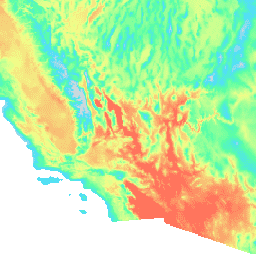
- Veri Kümesi Kullanılabilirliği
- 1900-01-01T00:00:00Z–2099-12-31T00:00:00Z
- Veri Kümesi Sağlayıcı
- University of California Merced
- Adım frekansı
- 1 Ay
- Etiketler
Açıklama
MACAv2-METDATA veri kümesi, ABD'nin bitişik eyaletlerini kapsayan 20 küresel iklim modelinden oluşan bir koleksiyondur. Çok değişkenli uyarlanabilir oluşturulmuş analoglar (MACA) yöntemi, geçmişteki önyargıları kaldırmak ve iklim modeli çıkışındaki mekansal kalıpları eşleştirmek için bir eğitim veri kümesi (ör. meteorolojik gözlem veri kümesi) kullanan istatistiksel bir ölçek küçültme yöntemidir.
MACA yöntemi, 20 küresel iklim modelinin (GCM'ler) model çıkışını ölçeklendirmek için kullanıldı. Bu modeller, Birleşik Model Karşılaştırma Projesi 5'in (CMIP5) tarihi GCM zorlamaları (1950-2005) ve gelecekteki temsili konsantrasyon yolları (RCP'ler) RCP 4.5 ve RCP 8.5 senaryoları (2006-2100) için GCM'lerin doğal çözünürlüğünden 4 km'ye kadar ölçeklendirildi.
Bu sürümde aylık özetler yer alır.
Modellerin tam listesini şu adreste bulabilirsiniz: https://climate.northwestknowledge.net/MACA/GCMs.php
Bantlar
Piksel Boyutu
4638,3 metre
Bantlar
| Ad | Birimler | Min. | Maks. | Piksel Boyutu | Açıklama |
|---|---|---|---|---|---|
tasmax |
K | 251,95* | 330,64* | metre | Yüzeye yakın günlük maksimum sıcaklığın aylık ortalaması |
tasmin |
K | 239,47* | 316,2* | metre | Yüzeye yakın minimum günlük sıcaklığın aylık ortalaması |
huss |
Kütle oranı | 0* | 0,03* | metre | Yüzeye yakın ortalama günlük özgül nemin aylık ortalaması |
pr |
mm | 0* | 3691,91* | metre | Yüzeydeki aylık toplam yağış miktarı |
rsds |
W/m^2 | 15,84* | 419* | metre | Yüzeydeki ortalama günlük kısa dalga radyasyonunun aylık ortalaması |
was |
m/sn | 0,23* | 14,16* | metre | Aylık ortalama günlük ortalama yüzeye yakın rüzgar hızı |
Resim Özellikleri
Resim Özellikleri
| Ad | Tür | Açıklama |
|---|---|---|
| senaryo | Dize | CMIP5 senaryosunun adı ("rcp85", "rcp45" veya "historical" değerlerinden biri) |
| model | Dize | CMIP5 modelinin adı (ör. "inmcm4") |
| ensemble | Dize | "r1i1p1" veya "r6i1p1" |
| ay | ÇİFT | Yıl içindeki ayın dizini (ör. 1-12) |
Kullanım Şartları
Kullanım Şartları
MACA veri kümeleri, ABD hükümetinin sağladığı fonlarla oluşturulmuş olup ABD'de kamu alanı kapsamındadır. Daha net bir şekilde ifade etmek gerekirse, aksi belirtilmedikçe MACA veri kümeleri Creative Commons CC0 1.0 Universal lisansıyla sunulur. Kısacası John Abatzoglou, telif hakkı yasası kapsamında dünya genelinde eser üzerindeki tüm haklarından (ilgili ve komşu haklar dahil) yasaların izin verdiği ölçüde feragat eder. İzin almadan, ticari amaçlar da dahil olmak üzere çalışmayı kopyalayabilir, değiştirebilir, dağıtabilir ve gerçekleştirebilirsiniz. John Abatzoglou, eserle ilgili hiçbir garanti vermez ve geçerli yasaların izin verdiği en geniş kapsamda eserin tüm kullanımlarıyla ilgili sorumluluğu reddeder. Kullanıcılar, bu veri kümesinin kullanımı sonucunda oluşturulan rapor ve yayınlarda kullanılan kaynağı uygun şekilde alıntılamalı ve verilerin elde edildiği tarihi belirtmelidir. Daha fazla bilgi için MACA Referansları ve Lisans sayfasına bakın.
Alıntılar
Abatzoglou J.T. ve Brown T.J., A comparison of statistical downscaling methods suited for wildfire applications, International Journal of Climatology(2012) doi:10.1002/joc.2312.
Earth Engine ile keşfetme
Kod Düzenleyici (JavaScript)
var dataset = ee.ImageCollection('IDAHO_EPSCOR/MACAv2_METDATA_MONTHLY') .filter(ee.Filter.date('2018-07-01', '2018-08-01')); var maximumTemperature = dataset.select('tasmax'); var maximumTemperatureVis = { min: 290.0, max: 314.0, palette: ['d8d8d8', '4addff', '5affa3', 'f2ff89', 'ff725c'], }; Map.setCenter(-115.356, 38.686, 5); Map.addLayer(maximumTemperature, maximumTemperatureVis, 'Maximum Temperature');
